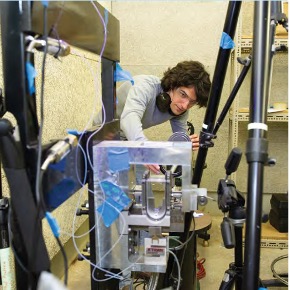Urban dwellers account for more than half of the world’s population today, with the World Health Organisation estimating that proportion increasing to 66% by 2050[1]. Take a moment to consider what you think our cities will look like in 33 years. Perhaps contemplate, most importantly, how healthy and happy will we be in these cities? Professor Frank Kelly hopes for urban spaces where vehicles are few and far between, where there are plenty of green spaces, and where people have easy access to public transport; that is his utopia. It’s a vision that many of us share, not least the network of like-minded colleagues who desire holistic solutions for urbanisation challenges.
Frank is Professor of Environmental Health at King’s College London, and a Fellow of the PLuS Alliance. As Director of the Environmental Research Group (ERG), and the Analytical & Environmental Sciences Division at King’s, Frank leads substantial research activity spanning all aspects of air pollution research. His work includes studies of the urban airshed within London, assessing the impact of growing up in a highly polluted urban environment on the development of lungs in school-aged children, and a study comparing health effects of air pollution on urban and rural Beijing residents. Air pollution is unique in that the health impacts are generally indiscriminate as all urban dwellers are exposed in the course of their daily lives. Addressing air pollution concerns therefore requires city-wide changes to be undertaken.
Under the PLuS Alliance, Frank has teamed up with colleagues from ASU and UNSW to work on an Informed Urbanisation project. The project team includes expertise from urban science, geographical science, urban planning, architecture, and data systems. Together, they aim to address urban development challenges by creating an interdisciplinary research programme, and developing educational courses. This dual research and education approach will help us better understand the multitude of influences our cities have on us and the planet, while also ensuring the next generation of researchers are equipped to continue solving urban development challenges.
A vast portfolio of peer-reviewed papers, conference papers and books would belie the fact that Frank did not begin his career in this area. Educated at Queens University in Belfast, Frank took his PhD in Physiology to Penn State University where he was a Postdoctoral Fellow. After working in the United States, Frank returned to the UK and took up a position as New Blood Lecturer at the University of Southampton where he continued pursing his interest in free radical biology and human disease; studying lung damage in premature babies, and in patients suffering from cystic fibrosis. In 1992, Frank relocated to London where he became Senior Lecturer at St Thomas’ Hospital. At this time there was an emerging understanding of the impact blooming urban city environments had on our health. Several cities in the UK experienced a ‘Great Smog’ during the 1950’s with further summer and winter smogs experienced during the 1990’s[2]. It became increasingly difficult to ignore the fact that cities had developed an air pollution problem. Research was showing both the negative effects of poor air quality on our respiratory health, and just how polluted the air in London was. The combination of research interests and a pressing global issue conspired to direct Frank towards investigating the impact pollutant particles have on our lungs and respiratory health.
Our lungs are protected by respiratory tract lining fluid (RTLF) that acts as the first line of defense against microscopic pollutant particles in our air. Just as some vitamins have antioxidant effects on our bodies, the RTLF reacts with oxidant molecules and free radicals to prevent or reduce damage to lung cells which lie beneath. By understanding how the RTLF interacts with pollutants from our urban environments, Frank believes we can better understand how air pollution effects our lung health, and also hopefully how to better protect our lungs. A recent research project conducted on school children in East London has established an association between growing up in an area with poor air quality and stunted development of healthy lungs. High traffic volumes in East London produce a great deal of nitrogen dioxide that fills the air local residents breathe. Children in this area appeared to have lower lung capacities than expected for their age, indicating that polluted environments can have a negative impact on the growth and development of our lungs. At about 18 years old, our lungs stop growing which means some children will never have the opportunity to ‘catch up’ on lung growth. As the generation of children raised in this environment ages, we should be concerned about their experience with respiratory system illnesses. With no sign of urban-living abating, we know that our pollution woes will not disappear. As Frank has acknowledged, “The more serious effects come from long term exposure to pollution, meaning many decades of exposure, and we know through research that people who live in areas with higher pollution concentrations tend to have lower life expectancies.” This research has become ever more important for avoiding a bleak urban future.
The interconnectedness of today’s world has taught us, among many things, that robust solutions come from utilising multi-disciplinary expertise. Creating urban environments that reduce stress and energy use, and are sustainable for future generations, requires improvements in the energy, transport and public health sectors just to name a few. Frank has, for many years, worked alongside colleagues from a variety of disciplines to provide a multi-faceted approach to his research. His leadership of the ERG has created an internationally recognized team with expertise in air quality science, toxicology, epidemiology and policy. Not only does this provide a comprehensive understanding of our interaction with the environment, but also gives the ERG authority when making recommendations for government policy and legislation. The translation of scientific evidence into effective policy is the key to creating our ideal urban spaces. Just as the research Frank and his colleagues conduct requires collaboration between disciplines, the creation of safe and healthy cities requires the joint efforts of scientists, policy makers, and the increasing number of people living and working in our urban areas.
For those of us not involved in research and policy making, there are a number of ways we can take precautionary measures, make positive lifestyle changes, and reduce personal emissions for the collective future benefit. For example, avoiding rush hour can reduce our exposure to particles from vehicle exhausts, wear and tear of tyres and road surfaces, and use of brakes. Use of public transport also reduces private vehicle use which can ease congestion on the roads. Frank is also an advocate of increasing active transport such as walking and cycling, describing it as having a “real health dividend” due to its dual benefit to our personal health, and the environment. Working in tandem with more energy efficient infrastructure, our collective contributions can significantly improve the future outlook for our cities.
As we continue asking questions and more research is conducted, Frank indicated a growing sense of urgency in this area with experts “getting more and more worried about the answers”. When asked if there are places Frank sees as examples of effective urban planning, he noted that small pockets exist but he has yet to see solutions operating at scale. He mentioned Christchurch in the South Island of New Zealand. The popularity of walking in the inner city area, use of electric trams and abundance of green space resonated with Frank who spent some time in New Zealand. The city of just under 400,000 people is known as New Zealand’s ‘Garden City’ with an abundance of flower and garden boxes, outdoor public seating areas, trees, and pedestrian malls. The mission now is to grow the portfolio of robust scientific research on air pollution and human health to motivate policy makers and city-dwellers towards larger-scale versions of cities such as Christchurch. Even beyond that, we need to ensure future generations are prepared to develop innovative solutions for our growing cities. We still have much to learn and even more to do, ensuring Frank’s crusade to improve the air quality for city-dwellers continues.


